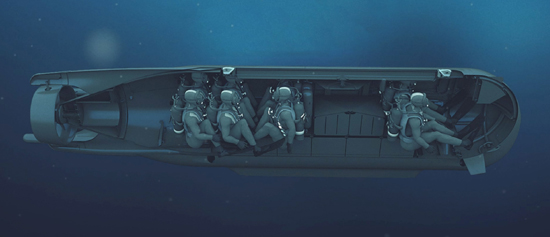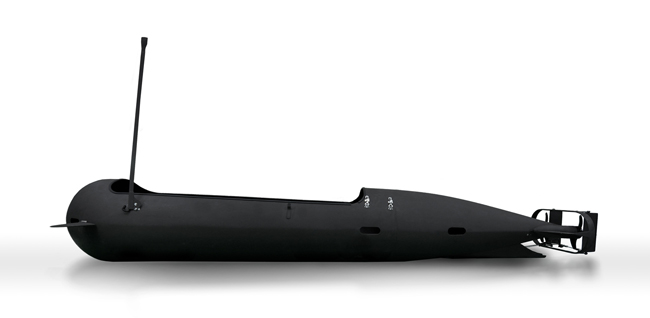
A range of Swimmer Delivery Vehicles (SDVs) known as The SEAL Pod was introduced today at DSEI 2013 by James Fisher Defence (JFD), a leading sub-sea rescue, operations and engineering company. The launch of The SEAL Pod is a result of JFD’s partnership with Swedish company DCE AB, a leading consultancy and manufacturer of specialist marine crafts.
The SEAL Pod vehicles are surface or sub-sea craft, each optimised for a particular deployment method or mission profile and can be provided in a number of configurations including a Sea Carrier, providing high speed surface transit, a submarine-launched Sub-SEAL for underwater delivery from a hanger or Torpedo SEAL, deploying two divers via the submarine torpedo tube.
The launch further strengthens FD’s Special Operations division as well as the breadth of products and solutions the company provides to covert operations markets, including special forces, law enforcement, counter-terrorism, maritime protection and mine countermeasures. “We are now seeing significant growth in navies looking to develop specific maritime skills for special forces, counter-terrorism and other areas of covert operations, which have declined due to the rise of land-based conflicts over the past decade. In conjunction with this, there is now a fundamental requirement for navies to keep their physical assets, including submarines and vessels, as far away from conflict as possible, which is leading to the integration of SDVs onto suitable submarines and other platforms.” said Ben Sharples, Managing Director, James Fisher Defence, “The SEAL Pod enables us to provide customers with a range of SDV solutions that meet their specific operational requirements. There is a myth that developing specialist maritime capabilities for these specific markets requires significant customer investment; the reality is that the focus must be on implementing a solution that fits with a navy’s current infrastructure, which can then be scaled accordingly as they develop their skills sets, and as new products and technologies come on line.”
[
caption id=”attachment_45385″ align=”alignnone” width=”650″] Sea Carrier, providing high speed surface transit. Photo: JFD[/caption]
Sea Carrier, providing high speed surface transit. Photo: JFD[/caption]
SEAL Carrier: Launched from a surface ship, SEAL Carrier vehicles transit at speeds greater than 30 kts on the surface before switching to submerged mode for a covert final approach. Surface propulsion is provided by an on-board diesel engine and water-jet. Submerged propulsion is delivered by an electric motor and thruster arrangement. SEAL Carrier vehicles can also be airdropped from fixed-wing aircraft. SEAL Carrier is controlled by two personnel; a Pilot and a Navigator, and can be used for mission profiles including; delivery of a 6-man combat team; host platform for Autonomous Underwater Vehicles; remotely operated weapons platform, harbour patrol vessel, rapid-response anti-piracy craft; and mine countermeasure operations. A smaller version of SEAL Carrier is also available, called Smart Seal. The export of Smart SEAL does not require an export license.

Sub SEAL: Sub SEAL vehicles are primarily launched from a hangar attached to the casing of a submarine and are operated fully submerged, at depths of up to 30m for the duration of a mission. The vehicles may approach, or break the surface for communication or reconnaissance purposes. Lithium Polymer batteries and a vectored-thruster arrangement provide the power, which enables sprint speeds of greater than seven kts, and a range of over 70 km. Sub SEAL vehicles may also be deployed by surface craft or rotary-wing aircraft. Sub SEAL is controlled by two personnel; a Pilot and a Navigator, and can be used for mission profiles including; delivery of a 6-man combat team; host platform for littoral survey package; electronic warfare of reconnaissance platform; port and estuary security; and mine countermeasure operations.
Torpedo SEAL: Torpedo SEAL transits within a NATO-standard torpedo tube. Once removed from the tube, Torpedo SEAL is fully extended and ready for use. It is then able to transport two divers and equipment, fully submerged, over a range of 7.5 nm. Torpedo SEAL can also be easily stowed within the multi-purpose tubes being integrated into future submarine designs, or beneath the outer casing of the submarine. Torpedo SEAL is controlled by a single pilot and can also accommodate one passenger and equipment. Torpedo SEAL can be used for mission profiles including; extending the operating range of a combat team; underwater survey and reconnaissance; delivery of explosive ordnance; counter narcotics and harbour patrol; and mine countermeasure operations.


















